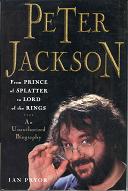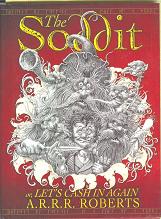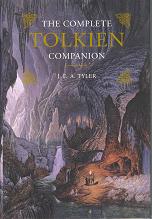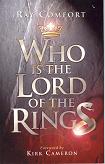TURGON'S BOOKSHELF:
More Brief Takes on Recent Books
Peter Jackson: From Prince of Splatter to Lord of the Rings: An Unauthorized Biography, by Ian Pryor (Thomas Dunne Books, St. Martin's Press, 2004). $24.99 hardcover (380 pp.), ISBN 0312322941
This is the first full consideration of Peter Jackson and his film career, covering thoroughly Jackson's first six films--Bad Taste, Meet the Feebles, Dead Alive (a.k.a. Braindead), Heavenly Creatures, Forgotten Silver, and The Frighteners--before moving on to the extensive coverage of the filming and release of The Lord of the Rings. Ian Pryor is a New Zealander, and has followed Jackson's career from very early on, but this is not an "authorized " biography, and Pryor faced many obstacles from Jackson, who discouraged people from speaking with him, and who requested that the New Zealand Film Commission not release movie stills and information for his use. Fortunately Pryor was able to interview many people, and the picture that emerges of Jackson is quite interesting. I was especially intrigued by the account of Heavenly Creatures, my own favorite of Jackson's films. There is a lot of fascinating information on the real murder case on which the film was based. But what will interest most TORn readers is the account of The Lord of the Rings, and Pryor gives that a very good overview (including bits on our own Tehanu being first presented with a trespass order before being unexpectedly invited on the set). Overall the book is well-done. My one complaint is that it lacks an index, a glaring omission.
J. R. R. Tolkien: Creator of Languages and Legends, by Doris Lynch (Franklin Watts,
2003). $29.50 hardcover library edition (127 pp.), ISBN 0531122530
Most biographies of J. R. R. Tolkien that are aimed at juveniles have been extremely poor in terms of quality and accuracy. Some are even ludicrous, and would be deservedly thrown into a dumpster but for the fact that some of the photographs reproduced in them are obscure and quite nice. Pity that the text surrounding the pictures is often so bad. Doris Lynch's juvenile biography is typical. A lot of information is taken from common sources like Humphrey Carpenter's biography, and regurgitated in such a way that facts become sweeping generalizations, and suppositions become facts. Lynch also likes to put forth banal motives and claim that that was what Tolkien thought:
"Ronald wanted to write about the past; a past where trees and flowers still graced the landscape and fairies might have flittered past. Tolkien wanted to construct a world similar to the magical, green island that he had journeyed to as a child from a distant land across the see. He wanted to celebrate the brave men who had fought during the war. He wanted to pay homage to the simple, honest country people he had met as a child in Sarehole. Most of all, after all the senseless death he had witnessed, he wanted to celebrate life." (p. 66)
Huh? Where does one begin to counter such nonsense? Beyond the nonsense there are a host of stupid errors. Irritation mounts, and then, turning the page, there is a nice picture... but of course the caption is wrong. Children deserve better work than this.
The Lord of the Rings Location Guidebook: Revised Edition, by Ian Brodie (HarperCollins New Zealand, 2003). $15.95 paperback (128 pp.), ISBN 1869504917
I got the first edition of this pocket-sized guidebook when it came out in 2002. It then covered only the first two Peter Jackson Lord of the Rings films, and amounted to 96 pages, with lots of seductive little pictures of the New Zealand landscape. If I hadn't already wanted to go there, this book would have convinced me that I wanted to--whether New Zealand had anything to do with Peter Jackson's films or not. The revised edition now fills 128 pages, and the short articles by Peter Jackson and Alan Lee in the first edition are reprinted, joined by new contributions by Richard Taylor and Barrie Osborne, and more by Peter Jackson. You should know instantly, by this description, if this book is for you.
Tolkien: A Look Behind The Lord of the Rings, by Lin Carter, revised and updated by Adam Roberts (Gollancz, 2003). £6.99 hardcover (188 pp.), ISBN 0575075481
Lin Carter died in 1988, and as regards his one volume study of Tolkien, it should have died with him. It had been published in 1969, and even then it seemed a breezy consideration of Tolkien, a kind of gushy fan's look at Tolkien and his roots. It has long been superseded. There are now many better books written by better writers and critics. This new edition has been supposedly "fully revised and updated" by Adam Roberts, who so far as I know has never published any criticism on Tolkien. Yet the book remains very much Lin Carter's book, and aside from some small updating here and there, the reviser's main contribution seems to be the extension of the postscript "After Tolkien" to cover selected writers since 1969, and the addition of three pages of bibliography, bringing the coverage from 1968 to 2002, to the "Checklist of Critical Literature on The Lord of the Rings." So the book remains a curiosity, an unwelcome visitor from the past. So far it has been republished only in England.
The Soddit, or; Let's Cash in Again, by A. R. R. R. Roberts (Gollancz, 2003). $9.95 pocket hardcover (343 pp.), ISBN 0575075546
This book is supposed to be a parody of The Hobbit. It was clearly inspired by commercial the success of Bored of the Rings, the classic parody of The Lord of the Rings. There is one major difference between the two. Bored of the Rings is funny. The Soddit is not. The bylined author A. R. R. R. Roberts is the same Adam Roberts who "revised" Lin Carter's Tolkien: A Look Behind The Lord of the Rings. Both book are published by the same publisher, evidently in an attempt to "cash in" on Tolkien. The author's blurb on The Soddit is typical of the type of unfunny, excessive wordage that fills page after page of the inside of the book. If you think this is funny, then maybe you will like the book.
"A. R. R. R. Roberts, the famous Stuttering Author, was born. He is married, and is precisely middle-aged, assuming that he will live to be seventy-six. His one-year-old daughter calls him Dada, possibly an allusion to the parallels between his life and the lives of Situationist radical avante-garde artists from the early twentieth century. Or perhaps for some other reason. Of his masterwork, the much-loved saga of Bingo the Soddit and his epic journey to confront Smug the Mighty Dragon, Roberts is on record as saying: 'How much? Alright. OK, OK, alright, when d'you want it done by? Yeah, yeah, I reckon that's doable.'"
The Complete Tolkien Companion, by J. E. A. Tyler (Thomas Dunne Books, St. Martin's Press, 2004). $27.95 hardcover (715 pp.), ISBN 0312315457
J. E. A. Tyler's book was first published in 1976 as The Tolkien Companion. A revised edition, expanded to cover The Silmarillion (1977), came out in 1979 as The New Tokien Companion. This new edition, with another slightly different title, is the third edition. Though there have been many new Tolkien publications relating to Middle-earth since the last revision, ranging from Unfinished Tales (1980) through the twelve volumes of the History of Middle-earth series, Tyler has opted to make the bulk of his updating from Unfinished Tales, using the History of Middle-earth volumes very sparingly. He explains his reasons for doing so in the "Foreword to the Third Edition," claiming that the History of Middle-earth "proves to be of limited relevance to the compiler of Middle-earth reference books." This is sheer laziness, and fatally limits the usefulness of Tyler's new edition. While the entries themselves are mostly sound, they are not as thorough as those by Robert Foster in his Complete Guide to Middle-earth, and unlike Foster, Tyler doesn't give page references for the sources of his information, and this seriously restricts the utility of his work. With such built-in limitations The Complete Tolkien Companion can never compete with Foster's Complete Guide to Middle-earth as the most useful encyclopedic guide to Tolkien's invented world.
Who Is The Lord of the Ring, by Ray Comfort (Bridge-Logos, 2002). $8.99 trade paperback (128 pp.), ISBN 0882708929
Take a look at the cover of this book. It appears that the title is Who is The Lord of the Rings, but it isn't. The final word is Ring singular. Yup, I got suckered into thinking this book was in some way related to Tolkien, but it isn't. It's basically the Gospel of John, retold in a dumbed-down version ("Comfort-able KJV") so insipid that even the low-wattage actor Kirk Cameron could read it and write a three paragraph "Foreword." Unless that's what you're looking for, you don't need this book.
* *
--Turgon
|
![[ Green Books ]](http://img-greenbooks.theonering.net/images/gb_logo.gif)
![[ Green Books - Exploring the Words and Worlds of J.R.R. Tolkien ]](http://img-greenbooks.theonering.net/images/gb_topnav.gif)








